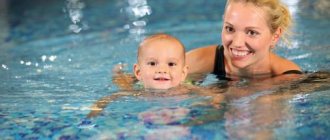June 01, 2018
Averyanova Sveta
It is very difficult to find a child who does not love water. For 9 months a little man swims in the amniotic fluid of his mother, they feed him, warm him, lull him to sleep, they are his natural environment, but after birth it is no longer easy to cope with the familiar elements on his own, he needs the help of an adult. Then every parent faces questions: how to teach a child to swim and at what age can a child be placed in the hands of a professional coach?
At what age can you start teaching your child to swim?
Physiologically, a child has the ability to swim from birth. While in his mother’s womb, he “swimmed” in amniotic fluid for nine months. Once born, a child can instinctively hold his breath and carry out rowing movements with his hands. There is, however, one peculiarity here: if you do not maintain this reflex during the first two months, it fades away.
In the 70s of the last century, scientists from Moscow even conducted research on this topic. Infants aged 1-2 months could easily float on water, and subsequently 80% of them demonstrated high resistance to colds.
Returning to the question of age, swimming training should begin when parents are ready for it. After all, they have to overcome difficulties together with the child and get rid of fears. On the one hand, the older the child, the easier it is to come to an agreement with him. In most cases, he himself already understands the benefits of swimming and is interested in learning.
When it comes to raising a professional swimmer, there is no point in wasting precious years. Sports trainers advise starting training at the age of 4 years. It is during this period that a natural thirst for something new and the physiological ability of the brain to quickly master coordinated movements of the arms and legs are noted.
Let's dive
Diving is a more responsible activity, but not difficult. The ability to dive and hold your breath is an important life skill that will protect your child from the danger of drowning. When accustoming your baby to it, you need to strictly follow the instructions.
- We learn to hold our breath. To force a child to do this, you just need to blow intensely on his face, then the baby will close his eyes and instinctively stop breathing for a while. At this time, you can start saying short phrases ending with the word “dive.” For example, “Masha, let’s dive!” and blow on your face. Next, we slowly pour water on the baby’s face from above, saying the same words - he must also hold his breath.
- Let's dive. When we have learned to hold our breath, we begin to make short dives under water. To begin with, we do this 2-3 times for 1 second, holding the baby tightly. After the child dives and comes up for the first time, he will be confused. Show him a positive reaction and praise. Gradually, the immersion time can be increased to 5 seconds, and their number - up to 5.
To maintain and develop the skill further, you can lower toys or other objects that are interesting to the baby and that he wants to get to the bottom of the bath. As a rule, children like such games.
How to overcome your fear of water?
If a student is afraid of water, you should not convince him otherwise. To achieve quick results, it is important that classes take place in a comfortable and safe environment. Parents should focus not on overcoming fear, but on creating a feeling of safety. You can do this as follows:
- give the opportunity to get used to the water. When the baby looks around and is not distracted by new sensations, it is worth talking about the properties of water. In age-appropriate language, tell them that water, if the body is positioned correctly, will keep it afloat and “push” it to the surface. Show that the ball does not sink in water, explain why this happens. The absence of fear will allow you to achieve the desired result faster;
- let you feel the ground under your feet. Do not rush to immediately take the student into depth. The water level to the chest is optimal in the first stages of training. Invite the future swimmer to play games. The “Fountain” exercise helps you get comfortable in the water: bend your knees slightly so that your lips are in the water. In this position, you should blow out air with your mouth until bubbles form. This activity will certainly entertain the child and help cope with anxiety. In the future, you can go to a depth where the water level reaches the collarbones.
When teaching, it is important to remain calm, not to rush the child, and not to raise your voice. A parent should be a “lifeline”, a “guide” on the path to the unknown. When the fear of water is left behind, they begin to learn to stay afloat. You shouldn’t delay this moment, because you get used to being in the water, touching the bottom.
Stay calm and be a confident guide for your child, not only in learning to swim, but in any other situation. Always know where your child is and what is happening around him so that you can provide him with timely help or support. Download the “Where are my children” application from the AppStore and GooglePlay stores.
Swimming pool or open water?
You can overcome your fear of water in the pool. There is less space, a comfortable temperature, the area is fenced - all this adds to the feeling of security. Judging by surveys of familiar parents, approximately half of children successfully master swimming in the pool. The young swimmer is not influenced by extraneous distractions (fish, stones, salt water, etc.). If necessary, you can show your child an instructor or other employee responsible for safety.
Transparent water will help the student control his movements, observe the position of his legs, and simply not be afraid of what is not visible in a muddy river. It is recommended to learn swimming in open waters at the age of at least 4 years. In any case, it is worth being guided by the situation and listening to the child’s condition.
Contraindications
There are very few contraindications to swimming, although they do exist.
- Acute otitis or tendency to otitis
- pneumonia, ARVI, acute respiratory infections with high fever
- skin diseases (infections, diathesis)
- severe congenital heart defects
- neurological pathologies that accompany seizure syndrome
- paralysis
- serious disorders of the musculoskeletal system, which require immobilization of the limbs
Basics of proper swimming in various styles
Regardless of the age at which the skill is mastered, it is important to know: the correct body position is horizontal with the face lowered into the water . It is instinctive for a person to raise his head. But a lowered face helps maintain balance and prevents the cervical vertebrae from overworking during prolonged exposure to water.
This position increases buoyancy and increases speed in any style. Therefore, when you learn “from scratch”, it is better to immediately develop the correct position, so as not to waste time and effort on relearning.
Sports swimming has 4 styles:
- Butterfly . This style is not suitable for children who are just learning. It requires great physical effort and well-functioning coordination of actions. During the movement, the swimmer “flies” over the water, making simultaneous swings of his arms and a splash of his legs, similar to the movements of a dolphin.
- Breaststroke. The arms perform wide, “spreading” movements, and the legs seem to push off from the surface of the water.
- Crawl on the chest. The fastest style: the arms make sweeping strokes, and the legs perform alternating scissor-type swings. Most of the time the swimmer's face is submerged in the water. In this case, inhalation occurs while turning the head.
- Back crawl. The movements are identical to the previous style, only the swimmer is on his back. This is a clear advantage for children who are not comfortable putting their face in the water.
If you are not raising a professional athlete, you should not immediately accustom him to a particular style. First of all, you need to practice breathing, leg and arm work.
Further development
Regardless of whether you went through the “express” option or the “academic” option, at this stage the child will not yet have developed the correct sports technique - he will simply learn to swim , but the movements will not be optimal.
Next, you need to seriously master the front and back crawl, breaststroke, and if you wish, you can also do the butterfly.
Four sports styles
I am convinced that the correct technique for these styles can only be taught by a coach or an experienced swimmer.
If you are initially targeting them, then, if possible, it is better to enroll your child in a pool section or for individual lessons with a trainer from the very beginning.
If this is not possible, then in addition to this article, I recommend that you read my articles on these swimming styles:
- crawl: technique, how to learn;
- breaststroke: technique, how to learn;
- backstroke swimming : how to swim and how to master it;
- butterfly: how to swim, training.
How to teach a child to swim?
If you practice every day, it is quite possible to achieve the desired result during a week-long vacation. There are even express methods developed by experienced instructors that allow you to master basic movements within one or two days. The most important thing here is not to force things and focus on the degree of readiness of your ward.
The learning process also depends on what you want to get as a result: whether you just need to teach your child to stay afloat or immediately master the desired style. If you are inclined to the second option, professional swimmers recommend starting with the crawl.
Naturally, when selecting exercises, it is important to focus on the student’s age. Next, we will consider basic techniques that correspond to age-related physiological and psychological characteristics.
Swimming training for preschool children
It is impossible to force a small, but already human, to swim without desire, and it does not make sense. At the age of 3-4 years, a child learns about the world through play. Therefore, in a playful way, you can instill in your baby the main skills, and the swimming technique will be practiced as he grows up.
We bring to your attention several exercises that will help you master the necessary movements:
- "Mill". Starting position: standing in chest-deep water, arms bent. You need to perform circular movements with your hands, immersing them as you lower them into the water. Here it is important to emphasize the correct order of immersion: first of all, the hands come into contact with the water, then the forearms, elbows, and shoulders.
- "Scissors". This task focuses on footwork. Holding the side or bottom with your hands (at shallow depths), the child will need to lie down on the water and alternately swing his legs up and down.
- "Jellyfish". Holding the student under the chest, ask him to lie face down in the water. The neck, legs and arms are as relaxed as possible. This position teaches you to stay afloat and not be afraid to dip your face.
- "Starfish". The body position is similar to the previous one, only the arms and legs are extended to the sides. You can complicate the task by adding exhalation into the water. If the child is not ready to lie face down, you can start the exercise from a supine position.
- "Heart". Starting position: standing, arms extended forward. Ask your child to “draw” a heart by spreading his arms to the side and bringing them together at the bottom. Shoulders and arms should be immersed in water.
- "Frog". The child holds onto the adult with his hands, moving his legs as if pushing off the water.
- "Jumping" in the water. Invite your baby to sit down and then jump, doing the previous two exercises at the same time. Be prepared to provide physical assistance (hold, catch) and psychological support to the beginning swimmer.
- "Float" . Starting position: standing. Take a deep breath and, squatting, sink to the bottom. Tell them in advance that you will need to hold your breath. As an incentive to perform, you can put some bright toy on the bottom.
Such training will help you get comfortable in the water and not cry if drops get into your eyes or nose. You can use protective equipment: glasses, a hat and other accessories to create maximum comfort for your child.
If you present training as a fun time with parents, the child will look forward to new exciting activities. By the way, such exercises provide a good psychoprophylactic effect and allow you to relieve muscle and emotional tension.
“Academic” methodology for teaching primary school children
The period from 7 to 10 years is characterized by awareness in performing exercises. There is no longer any need to invent exciting activities in a playful way. The younger student is ready to learn to swim on his own initiative. Of course, parents should not forget that motivation at this age still depends on external factors. Therefore, as with children, it is important to create an atmosphere that stimulates activities, arouses interest and brings positive emotions. Use praise often and avoid ridicule.
Now let's move on to practice. Step-by-step implementation of the exercises described below is a guarantee that the child will learn to swim:
- Breathing into the water. Starting position: standing, immersing your face in the water, hands holding the handrails. In this case, you need to exhale air through your nose or mouth until a “boil” forms. Such exercises are done 10 to 15 times before starting training.
- Swimming with a board . Starting position: lying on the water, holding the board. Arms extended. The face is lowered into the water. Moving forward is carried out due to the movement of the legs. The legs work from the hip without bending at the knee. It is important to follow the breathing technique here: to inhale, lift your face up, exhale into the water. Mastering swimming with a board can take from one to several lessons, depending on your student’s readiness.
- "Arrow" . The exercise is similar to the previous one, but is performed without a board. This task is a kind of test: if the child has coped with it, then it is worth moving on to the next stage.
- Connecting hands. There may be three options:
- if the leg movements were performed in the breaststroke style, then the arm movements are performed in the same style. You will receive a “ready” breaststroke, all that remains is to hone your skills;
- if the legs moved with the crawl, “breaststroke” movements with the arms are allowed. In this case, the child will master the “doggy style” technique, which is intuitive and allowed at the initial stages;
- and the third option: legs when swimming - crawl, hand strokes - also crawl. With parallel training in sideways breathing, the child will fully master this style.
Of course, it’s too early to talk about the ideal performance technique at this stage. But the child already knows how to float on the surface of the water and move forward.
Teaching your child to swim before traveling? Be calm about him not only in the water, but also on land. To prevent your child from getting lost in a strange place, download the “Where are my children” application with GPS function and LIVE wiretapping from the AppStore and GooglePlay stores.
“Express option” for younger students
If you think the above method is too complicated or time-consuming (especially when summer is in full swing and you want to teach your child to swim freely in a matter of days), try another way. It will allow you to achieve results in a short time, without focusing on practicing the technique.
The essence of the classes comes down to several exercises:
- Starting position: lying on the water, hands resting on the bottom. Immerse your face in water 10 times and relax your neck muscles. Naturally, the exercise can only be performed at shallow depths.
- Perform the same actions with one hand lifted from the bottom of the pool.
- Perform the same actions with alternately lifting your hands off the bottom.
When the child has mastered the third task, ask him to remove both hands at once. In this way he will learn to “lie” on the water. But that's only half the story. Next you should teach him to move forward. You can do this using the following exercises:
- Starting position: lying on the water, smoothly straighten your arms forward. Remember that haste and jerking are of no use here.
- While on the water with your arms outstretched, push off the side with your feet and “slide” forward. When this is achieved, we add movements with the legs (just move them without focusing on the technique of execution). Having mastered moving with the legs, we also connect the arms without reference to the style. Let the child move them the way he feels comfortable. The only requirement: do not put your hands behind your body so that you can raise your face above the water without losing balance.
- Raising your head. At first, you should raise your head without inhaling. It is important to work out the sequence of actions. When this happens, add an inhale over the water.
This method was proposed by coach D. Tarakanov. The author claims that the desired result can be achieved in just one lesson.
Middle and high school age
You can train a teenager using the methods outlined above. After 12 years of age, it is easier for children to complete the tasks described; they easily learn the instructions. Difficulties that arise during learning, most often, can be caused by psychological issues:
- strong fear of water (as a result of unsuccessful attempts to swim earlier);
- lack of contact with the “teacher”;
- persistent reluctance to learn.
Here the adult needs to find an approach to the older student, motivate him to acquire new skills, and demonstrate the benefits of swimming. Once a trusting relationship has been established, you can begin training.
Group classes
From the outside it seems that group swimming lessons for children are easier and cheaper. The latter - yes, but not easier. Great responsibility lies with the instructor, who simultaneously monitors several children. Each of the guys strives to show off their skills, and this can end badly. Therefore, it is better to choose a section where a children’s swimming coach, having experience, can teach a child to swim in the pool efficiently and, most importantly, safely.
Group swimming
For your information! It is problematic to immediately create a group where all participants are approximately the same level. If part of the group lags behind, then the rest have nothing to do.
Group swimming technology implies one program for all group members.
How to teach a child to swim in the pool? The answer is simple - use small training groups for beginners. Not 10-20 people, but three kindergarten students, maximum five. With such a system, the results of each lesson are much higher.
Errors in learning
In addition to following the techniques and rules described above, it is important to avoid other mistakes. Let's note what to avoid during lessons:
- do not resort to extreme methods. Throwing yourself into the water relying on innate instincts has nothing to do with learning. This “old-fashioned” method is fraught with serious psychological consequences: from a persistent fear of water to distrust of parents (much depends on the age at which a person experienced a similar situation);
- Don't ignore your student's mood. If he is worried, anxious or upset about something, listen to him and only then decide to continue the lesson;
- Don't give negative feedback to unsuccessful attempts. Focus on successes. They definitely exist;
- Don't expect a child's coordination to be identical to an adult's. Consider age-related physiological capabilities;
- do not use inflatable rings. They form an incorrect habit of standing upright. To protect your baby and reduce the load, it is better to use vests or armbands (and if possible, it is better to do without them altogether).
That’s probably all that parents who are starting to learn the profession of a personal instructor need to know. Help your child fall in love with the water, teach him basic movements, practice hand-foot coordination and proper breathing. Do not rush to start a new stage if the child has not learned and consolidated the acquired skills. During classes, follow the recommendations described in the article, take into account the age and psychological characteristics of the ward, maintain a positive attitude and believe in yourself!
Adviсe
Do not skimp on praise and approving phrases! Your sincere support and understanding will help the baby cope with his fears and give him enthusiasm for possible failures.
Teach your child to swim only when you are convinced that he does not have otitis, does not have a tendency to have it frequently, and generally feels good.
Don't push if your baby doesn't want to do something or is tired. So, everything has its time. Continue to master various games in the water after the baby has rested or warmed up.
Pay attention to the child's body - blue lips, goose bumps and a trembling chin are a signal that it's time to take a break and warm up.











